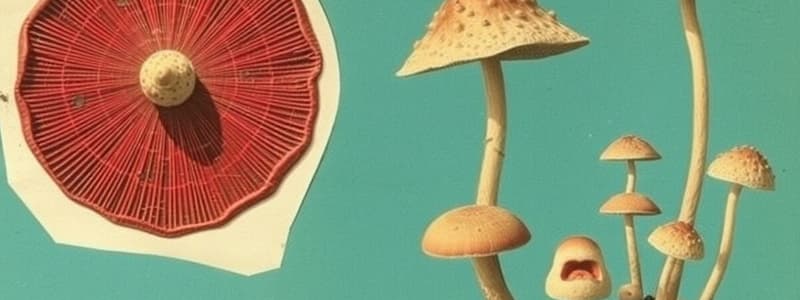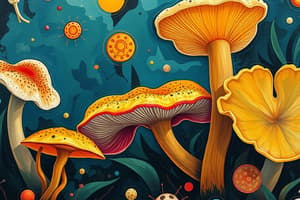Podcast
Questions and Answers
Approximately how long ago did scientists believe fungi first appeared?
Approximately how long ago did scientists believe fungi first appeared?
- 2 billion years ago
- 500 million years ago
- 100 million years ago
- 1.5 billion years ago (correct)
Early fungi played a significant role in helping which organisms move onto land?
Early fungi played a significant role in helping which organisms move onto land?
- Plants (correct)
- Insects
- Animals
- Reptiles
What material makes up the strong cell wall of fungi, helping them resist drying out?
What material makes up the strong cell wall of fungi, helping them resist drying out?
- Cellulose
- Lignin
- Pectin
- Chitin (correct)
Which group of fungi is considered the most basic type and primarily lives in water?
Which group of fungi is considered the most basic type and primarily lives in water?
Which fungal group includes mushrooms, puffballs, and bracket fungi?
Which fungal group includes mushrooms, puffballs, and bracket fungi?
Which group of fungi forms special partnerships with plant roots, helping plants get nutrients from the soil?
Which group of fungi forms special partnerships with plant roots, helping plants get nutrients from the soil?
What is the name of the sac-like structures in which Ascomycetes make their spores?
What is the name of the sac-like structures in which Ascomycetes make their spores?
How do Glomeromycetes primarily reproduce?
How do Glomeromycetes primarily reproduce?
What is the name of the thick-walled container for baby fungi formed by Zygomycetes during sexual reproduction?
What is the name of the thick-walled container for baby fungi formed by Zygomycetes during sexual reproduction?
Which of the following is a basis for classifying fungi?
Which of the following is a basis for classifying fungi?
Flashcards
Fungi's evolutionary relatives
Fungi's evolutionary relatives
Fungi are more closely related to animals than plants, sharing a common ancestor.
Early Fungi Characteristics
Early Fungi Characteristics
Early fungi, resembling modern chytrids, were simple, water-dwelling organisms with swimming spores.
Chitin
Chitin
A tough polysaccharide that forms the cell walls of fungi, providing protection and preventing drying out.
Chytridiomycota (Chytrids)
Chytridiomycota (Chytrids)
Signup and view all the flashcards
Zygomycota (Zygomycetes)
Zygomycota (Zygomycetes)
Signup and view all the flashcards
Ascomycota (Ascomycetes)
Ascomycota (Ascomycetes)
Signup and view all the flashcards
Basidiomycota (Basidiomycetes)
Basidiomycota (Basidiomycetes)
Signup and view all the flashcards
Glomeromycota (Glomeromycetes)
Glomeromycota (Glomeromycetes)
Signup and view all the flashcards
Morphological Classification
Morphological Classification
Signup and view all the flashcards
Reproductive Classification
Reproductive Classification
Signup and view all the flashcards
Study Notes
- Fungi first appeared approximately 1.5 billion years ago.
- Fungi share a common ancestor with animals, making them more closely related to animals than plants.
- The history of fungi illustrates their adaptation to diverse environments and their ecological importance.
Early Evolutionary Stages
- The earliest fungi were likely simple, water-dwelling organisms.
- Early fungi probably resembled modern chytrids.
- Chytrids typically live in aquatic environments and possess spores with tails for swimming.
- Early fungi played a crucial role in facilitating the transition of plants onto land by forming partnerships with early land plants.
Adaptation to Terrestrial Life
- Fungi developed adaptations for survival on land, including a strong cell wall made of chitin.
- Chitin constitutes the hard outer shells of insects and other arthropods.
- The chitinous cell wall protects against desiccation and other environmental stressors.
Diversification and Modern Groups
- Fungi diversified into several main groups, each with unique characteristics and ecological roles.
- The diversification resulted in the wide variety of fungal types observed today, differing in shapes, reproduction methods, and environmental interactions.
Major Groups of Fungi
- Fungi are classified into main groups based on morphology, reproduction, and genetic makeup.
Chytridiomycota (Chytrids)
- Chytrids are the most basal fungal group.
- They generally live in water and produce motile spores.
- Chytrids break down dead organic matter in aquatic environments and can cause diseases in amphibians.
- Chytrids are usually very simple, often unicellular or composed of a few cells without internal walls.
- They reproduce both sexually and asexually, often forming sporangia that release swimming spores.
Zygomycota (Zygomycetes)
- Zygomycetes primarily inhabit terrestrial environments and decompose dead plants and animals.
- Sexual reproduction involves the formation of a zygosporangium, a thick-walled structure containing developing fungi.
- Zygomycetes have long, tube-like structures without internal walls and produce non-motile spores.
- Sexual reproduction involves the fusion of specialized fungal parts to form a zygosporangium. Asexual reproduction occurs through structures that release spores.
Ascomycota (Ascomycetes)
- Ascomycetes represent one of the largest and most diverse fungal groups.
- They produce spores within sac-like structures called asci.
- Ascomycetes include yeasts, molds, and morels.
- Ascomycetes have long, tube-like structures with internal walls and form asci to hold their spores.
- Sexual reproduction involves the formation of asci, while asexual reproduction often produces spores called conidia.
Basidiomycota (Basidiomycetes)
- Basidiomycetes produce spores on structures called basidia.
- This group includes mushrooms, puffballs, and bracket fungi.
- They are crucial for decomposing dead organic matter and forming symbiotic relationships with plant roots.
- Basidiomycetes have long, tube-like structures with internal walls and create basidia to hold their spores.
- Sexual reproduction involves the formation of basidia and basidiospores; asexual reproduction may involve conidia.
Glomeromycota (Glomeromycetes)
- Glomeromycetes are a smaller group that forms symbiotic relationships with plant roots.
- These partnerships facilitate nutrient uptake from the soil for plants.
- Glomeromycetes have long, tube-like structures without internal walls and form specialized structures inside plant roots.
- They primarily reproduce asexually by producing spores.
Basal Lineages
- Some fungi do not fit neatly into the main groups including insect-infecting fungi (Entomophthoromycota) and some aquatic fungi (Blastocladiomycota).
Fungal Classification
- Fungal classification is based on morphology, reproduction, and genetic information.
- Historically, classification relied heavily on morphological characteristics.
- Genetic information is now used to better understand relationships between different fungi.
Morphological Classification
- Classifying fungi based on their physical appearance.
- Key morphological features include: hyphal structure, reproductive structures, and spore appearance.
Reproductive Classification
- Fungi are grouped based on their methods of reproduction.
- Sexual reproduction involves the fusion of specialized fungal parts.
- Asexual reproduction involves spore production without fusion.
Genetic Classification
- Modern classification uses genetic material to determine fungal relationships.
- Genetic analysis has revealed new relationships and led to reclassification of some fungi.
Studying That Suits You
Use AI to generate personalized quizzes and flashcards to suit your learning preferences.




